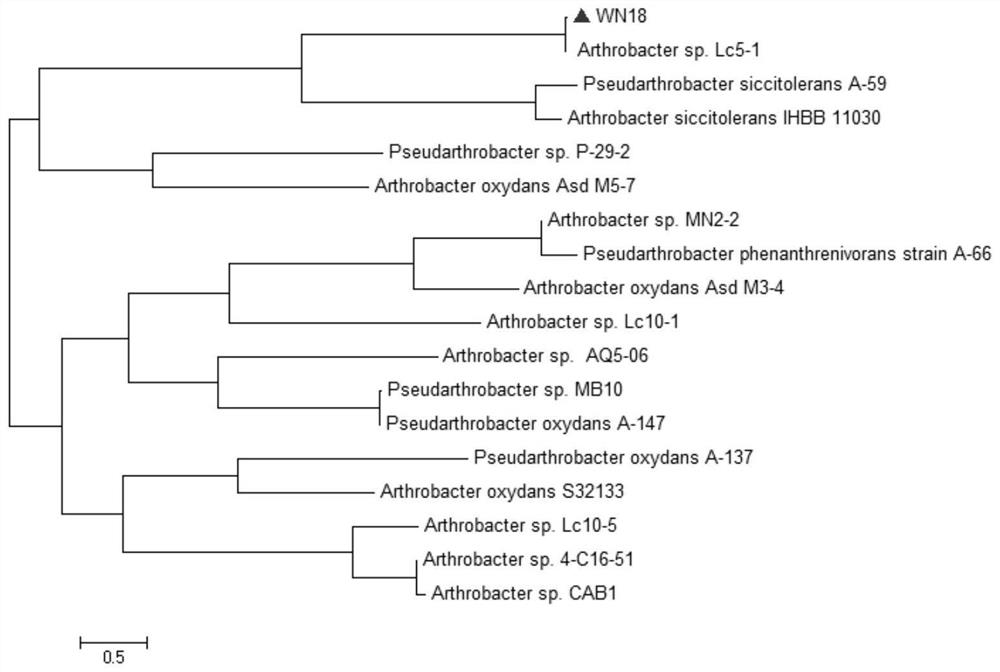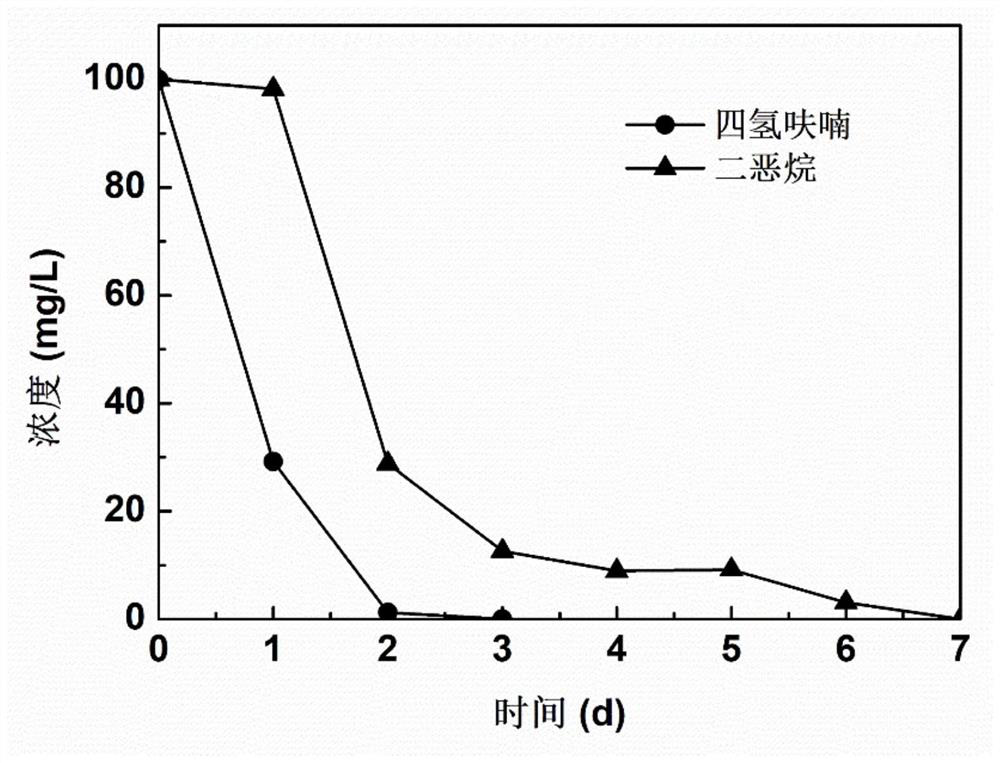Arthrobacter sp. WN18 and application thereof
A technology of Arthrobacter, microbial strains, applied in bacteria, water/sludge/sewage treatment, biochemical equipment and methods, etc.
- Summary
- Abstract
- Description
- Claims
- Application Information
AI Technical Summary
Problems solved by technology
Method used
Image
Examples
Embodiment 1
[0030] 1. Isolation of strains
[0031] a, the preparation of ammonium salt inorganic salt medium (AMS)
[0032] 1L ammonium salt medium includes the following components: 100ml of 10-fold concentrated salt solution, 1.0mL of stock solution A, 20mL of 1.0M phosphate buffer and 1.0mL of trace elements, with a pH of about 7.08.
[0033] l0 times concentrated salt solution: 6.6g / L (NH 4 ) 2 SO 4 , 10.0g / L MgSO 4 ·7H 2 O, 0.15g / L CaCl 2 ·6H 2 O.
[0034] Stock solution A: 5.0g / L Fe-EDTA, 2.0g / L Na 2 MO 4 4H 2 O.
[0035] 1.0M phosphate buffer: 2.26g / L KH 2 PO 4 , 0.94g / L Na 2 HPO 4 .
[0036] Trace elements: 0.25g / L EDTA, 0.5g / L FeSO 4 ·7H 2 O, 0.4g / L ZnSO 4 ·7H 2 O, 0.01g / LNiCl 2 ·6H 2 O, 0.015g / L H 3 BO 3 , 0.05g / L CoCl 2 ·6H 2 O, 0.005g / L CuCl 2 2H 2 O, 0.02g / LMnSO 4 ·H 2 O. The components were autoclaved at 121°C for 15 minutes.
[0037] b. Phosphate buffered saline (PBS) (per liter): 0.24g KH 2 PO 4 , 1.44 g Na 2 HPO 4 , 8.0g NaCl, 0.2g KCl...
Embodiment 2
[0047] Strain WN18 was cultured in AMS medium containing 200 mg / L tetrahydrofuran, and incubated at 30° C. in a rotary shaker at 160 rpm for 48 hours. Cells were harvested in exponential phase by centrifugation at 12,000g for 5 min at 4°C, and the cell pellet was washed 3 times with sterile PBS buffer, then resuspended in fresh AMS for further studies. In each 100ml glass vial, add 20ml of AMS, and add different concentrations of tetrahydrofuran and / or dioxane, then inoculate the resuspended cells with the initial concentration of 0.01Abs (OD600nm), and seal with a butyl rubber stopper, and The cultivation was performed at 160 rpm and 30°C in a rotary shaker.
[0048] a. Add 100mg / L of tetrahydrofuran and dioxane respectively, and their co-metabolism degradation results are as follows image 3 As shown, when the two substrates were added to 100 mg / L at the same time, strain WN18 preferentially removed THF, and then began to degrade dioxane after the concentration of THF dropp...
Embodiment 3
[0052] In order to evaluate the environmental adaptability of WN18 bacteria to co-metabolize and degrade dioxane under different pH and temperature conditions with tetrahydrofuran as the induction substrate. The initial pH of the AMS was adjusted to 3.0, 5.0, 7.0, 9.0 and 11.0. The degradation experiments were carried out under the conditions of AMS (pH 7.1) under natural conditions at temperatures of 4°C, 15°C, 25°C, 35°C, and 45°C.
[0053] The experimental results of the WN18 strain of the present invention under different conditions are as follows: Figure 6 and 7 shown. The results show that the strain can be used at pH (5.0-11.0) ( Figure 6 ) and temperature (4-42°C) ( Figure 7 ) co-metabolic degradation of dioxane. Among them, the optimum pH and temperature are 7.0 and 35°C, respectively. The pH value of 3.0 completely inhibited the removal of dioxane, and it still had strong dioxane degradation ability at 11.0. When the temperature increased from 15°C to 35°C,...
PUM
 Login to View More
Login to View More Abstract
Description
Claims
Application Information
 Login to View More
Login to View More - R&D
- Intellectual Property
- Life Sciences
- Materials
- Tech Scout
- Unparalleled Data Quality
- Higher Quality Content
- 60% Fewer Hallucinations
Browse by: Latest US Patents, China's latest patents, Technical Efficacy Thesaurus, Application Domain, Technology Topic, Popular Technical Reports.
© 2025 PatSnap. All rights reserved.Legal|Privacy policy|Modern Slavery Act Transparency Statement|Sitemap|About US| Contact US: help@patsnap.com



